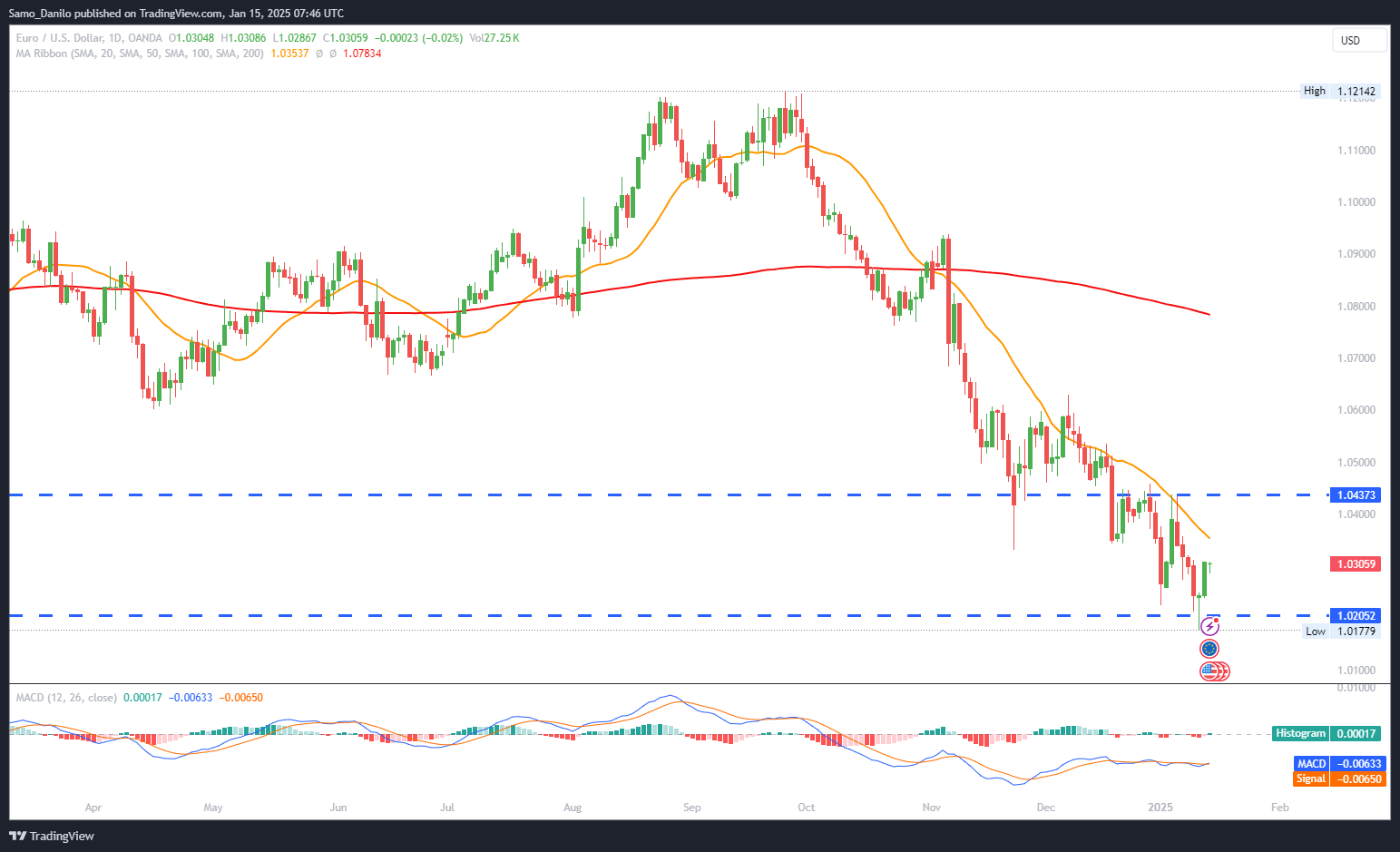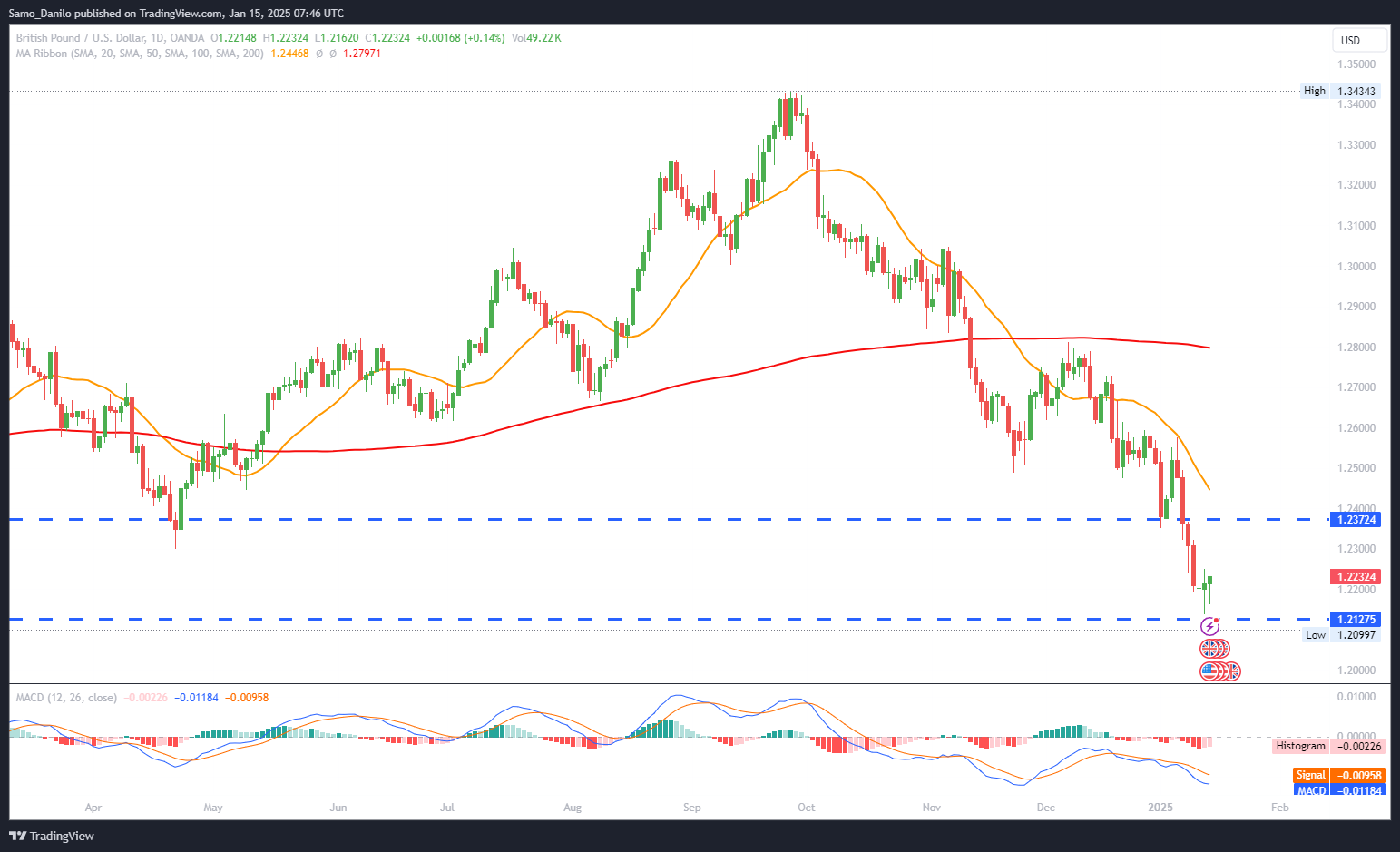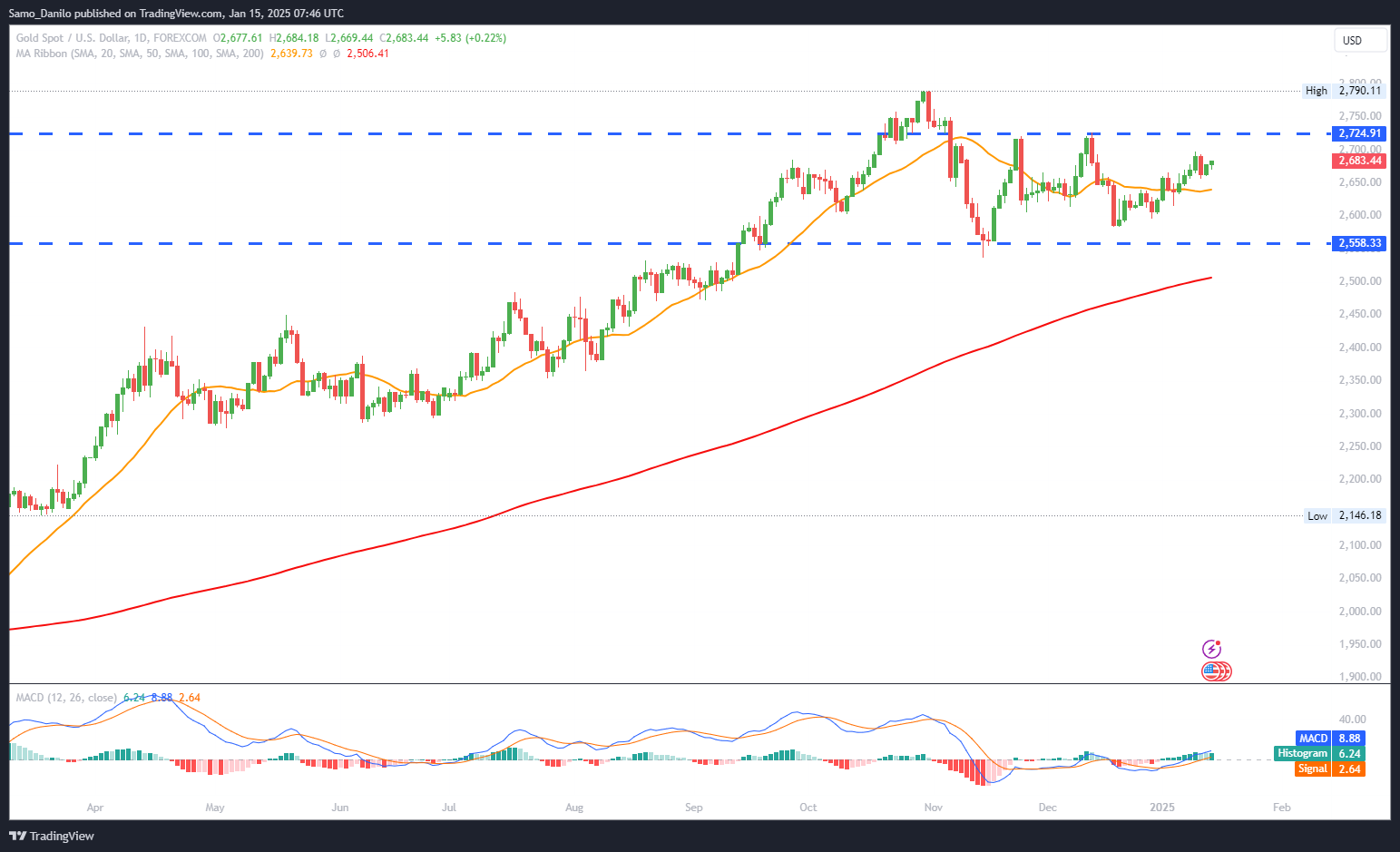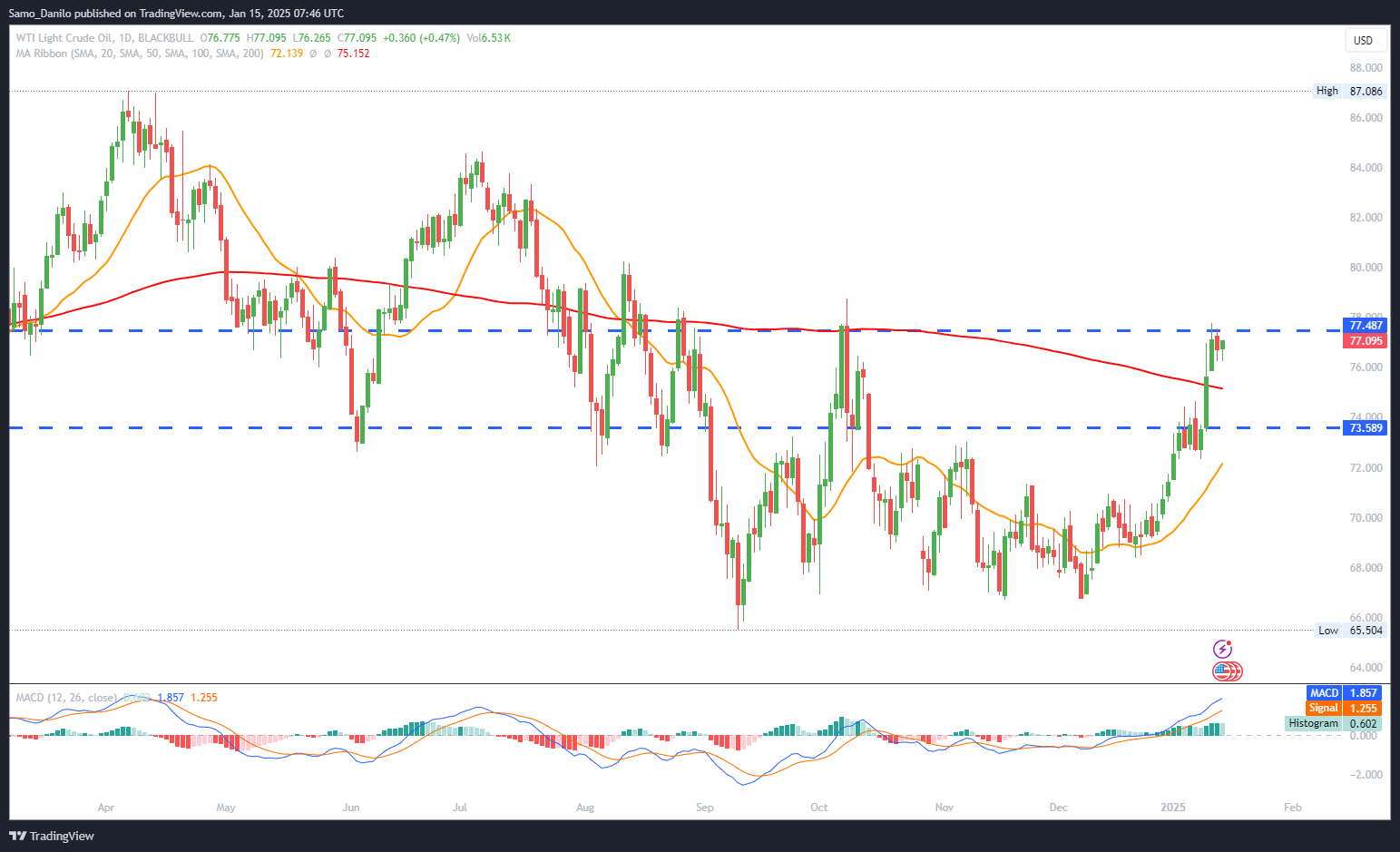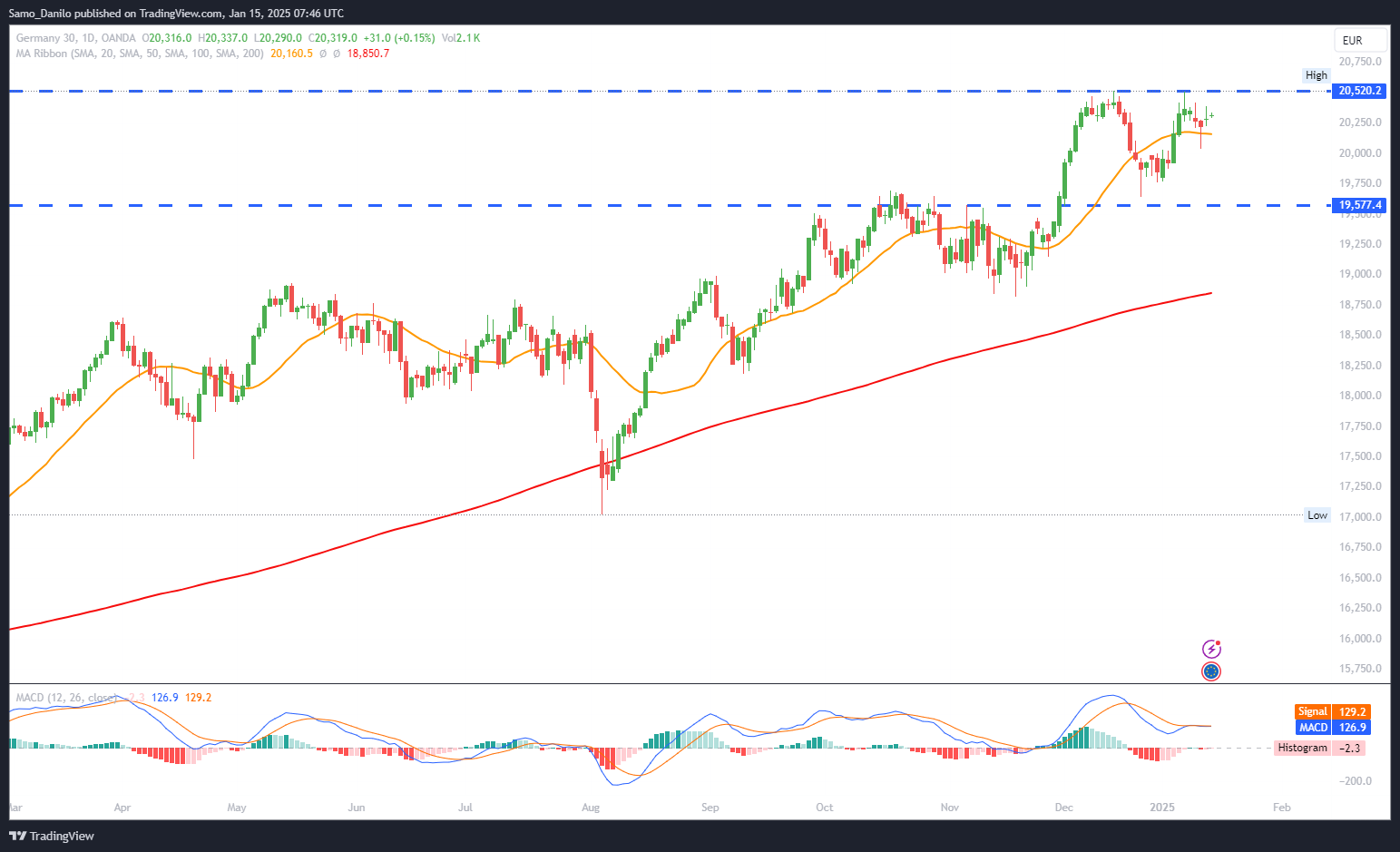EURUSD
- EUR/USD Price: The EUR/USD pair holds steady around 1.0300 during European trading hours on Wednesday, consolidating gains from the previous session. The pair reflects cautious optimism as traders await further economic data.
- ECB Policy Outlook: ECB policymaker Olli Rehn stated that the central bank's monetary policy is expected to exit restrictive territory by midsummer. This aligns with a potential shift in the ECB’s tightening cycle, which could influence the Euro’s medium-term trajectory.
- Eurozone Economic Releases: Significant Eurozone data is scheduled for release, including Industrial Production on January 15 and Germany’s final Inflation Rate and ECB meeting accounts on January 16. Additionally, ECB Vice President Luis de Guindos’ speech on January 16 will be closely monitored for policy insights.
- US PPI Data: The US Producer Price Index (PPI) for December rose by 0.2% month-over-month, lower than the 0.3% forecast. However, the PPI’s 3.3% year-over-year increase marked its highest level since February 2023, signaling underlying inflation pressures and supporting the US Dollar.
- US CPI Data: The release of the US CPI inflation data later on Wednesday will be pivotal for EUR/USD direction. Expectations of softer inflation could reduce the likelihood of aggressive Fed rate hikes, offering potential upside for the Euro.
Closing statement: The EUR/USD pair remains range-bound, with market sentiment influenced by mixed economic data and diverging central bank policies. Near-term movements will likely hinge on upcoming Eurozone data and the critical US CPI release, which may set the tone for future rate decisions.
GBPUSD
- GBP/USD Price: GBP/USD remains under pressure, trading below the 1.2200 mark during Wednesday’s European session. The pair extends its bearish bias amid a weaker UK economic outlook and subdued investor sentiment.
- UK Inflation Data: The UK December CPI inflation declined to 2.5% YoY, below the expected 2.7%. Additionally, a sharp drop in services inflation to 4.4% added to concerns over the UK economy, further dampening the appeal of the Pound Sterling.
- UK Fiscal Concerns: Analysts warn that elevated borrowing costs could prompt the UK government to cut spending or increase taxes to adhere to fiscal rules. This scenario may weigh on long-term growth prospects, intensifying bearish pressure on GBP.
- US Dollar: The US Dollar hovers near its weekly low following softer-than-expected US producer price data. However, this offers limited support to GBP/USD, as the broader narrative remains skewed in favor of the USD.
- Fed Policy: Market participants anticipate that the US Federal Reserve will pause its rate-cutting cycle later this month, supported by a strong US Nonfarm Payrolls (NFP) report released last Friday. This reinforces the Dollar's resilience against the Pound.
Closing statement: GBP/USD struggles to gain traction as weaker UK inflation data and fiscal challenges weigh on the Sterling. While a softer US Dollar tempers the downside, the pair remains vulnerable amid diverging economic fundamentals. Near-term focus will shift to additional UK economic releases and updates on US monetary policy.
XAUUSD
- Gold Price: The XAU/USD pair faces downward pressure as a risk-on sentiment drives investors away from safe-haven assets like gold. Expectations of a slower pace of Fed rate cuts further contribute to reduced demand for gold.
- Technical Indicators: Despite the bearish momentum, technical indicators on the daily chart remain supportive of potential dip-buying. Buyers may emerge near the $2,663–$2,662 range, offering some downside protection for the XAU/USD pair.
- US PPI Data: Data released on Tuesday showed the US Producer Price Index (PPI) rising 3.3% annually in December, below the 3.4% market expectation. Core PPI inflation increased by 3.5% YoY, also falling short of forecasts. This softer inflation data provides some relief for gold but fails to reverse its broader bearish trend.
- Fed Outlook: Hawkish Federal Reserve bets remain intact, with expectations that President-elect Donald Trump’s upcoming second-term policies may fuel inflation. These expectations strengthen the US Dollar and pressure non-yielding assets like gold.
- US CPI Data: Traders are now focusing on the upcoming US Consumer Price Index (CPI) data for further insights into the Fed's monetary policy direction. A higher CPI reading could reinforce the hawkish Fed narrative, intensifying selling pressure on XAU/USD.
Closing statement: Gold prices remain vulnerable as risk-on sentiment and hawkish Fed expectations dominate. While technical support near $2,662 may attract buyers, the pair’s outlook depends heavily on the upcoming US CPI data, which could further clarify the Fed’s policy trajectory.
CRUDE OIL
- WTI Prices: West Texas Intermediate (WTI) crude oil trades around $78.00 on Wednesday, gaining ground as new US sanctions on Russian oil exports heighten fears of tighter global supplies. The geopolitical landscape continues to exert upward pressure on crude prices.
- EIA Outlook: The US Energy Information Administration (EIA) reported that global oil production is currently outpacing demand, which could dampen upward momentum in WTI prices. This imbalance serves as a potential headwind for further price gains.
- API report: US crude oil inventories fell by 2.6 million barrels for the week ending January 10, according to the API report. This draw was less than anticipated, signaling weaker demand and adding to the bearish sentiment in the market.
- Geopolitical Risks: Ukraine launched its largest air attacks on Russia since the start of the war, prompting Russian retaliation. Concurrently, Israel intensified strikes on Gaza amid ongoing negotiations for a ceasefire. These developments contribute to heightened geopolitical risks, which support oil prices in the short term.
- Ceasefire Negotiations: Intense discussions in Qatar regarding the Gaza ceasefire are reportedly nearing a breakthrough. Any resolution could reduce geopolitical tensions, potentially limiting crude oil's risk premium in the near future.
Closing statement: WTI crude oil prices find support from escalating geopolitical risks and US sanctions on Russian oil, but weaker demand signals and oversupply concerns may cap gains. Traders will closely monitor geopolitical developments and US inventory data for further price direction.
DAX
- DAX Price: The DAX rose by 0.69% on Tuesday, reversing Monday’s 0.41% loss and closing at 20,271. Sentiment improved following reports that Trump's economic team is considering a gradual rollout of monthly tariffs. However, uncertainty surrounding potential US tariffs on EU goods remains a significant headwind.
- German Wholesale Prices: Data released on Wednesday showed German wholesale prices rose by 0.1% year-on-year in December, rebounding from a 0.6% decline in November. This marginal increase points to a slight improvement in domestic demand, offering a glimmer of optimism for the struggling German economy.
- Germany’s GDP: Germany’s full year GDP numbers require consideration today. Economists expect the economy to contract by 0.2% in 2024 after contracting by 0.3% in 2023.
- US Producer Prices: On Tuesday, US core producer prices rose 3.5% year-on-year in December, mirroring November’s growth. This data provided markets with some respite but kept attention focused on the US CPI Report for more decisive insights into the Federal Reserve’s monetary policy trajectory.
- US CPI Report: Scheduled for release later on Wednesday, the US CPI Report will be a crucial factor influencing global market sentiment and the Federal Reserve’s rate outlook. Economists forecast core inflation to hold steady at 3.3% in December, a result that could shape risk appetite and impact equity markets like the DAX.
Closing statement: The DAX’s recovery reflects cautious optimism amid tariff discussions and stabilizing German wholesale prices. However, concerns about weak GDP growth and external risks from US economic policy persist. Traders will closely monitor US inflation data for potential market-moving developments.
